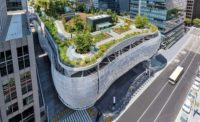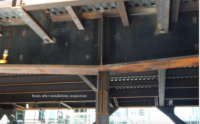Initial stabilization of two problem built-up plate girders at the Salesforce Transit Center in seismically active San Francisco, using a beam and tower shoring system to relieve loads on the girders, is scheduled to begin today, Sunday, Sept. 30, according to the Transbay Joint Powers Authority, which opened the nearly $2.3-billion hub in August.
TJPA closed the 1.2-million-sq-ft transit center, currently a bus depot with three levels above grade and a 5.4-acre rooftop public park, on Sept. 25, soon after a metal ceiling installer noticed a crack in the bottom flange of an 80-ft-long welded tapered girder spanning Fremont Street. The third-floor girder supports the park directly above and the second-floor bus level, via a hanger, directly below. Fremont Street, below the affected area, also is closed to traffic.
An investigation then uncovered a second but smaller brittle fracture in a twin parallel girder. TJPA reports its investigators, led by the hub’s structural engineer Thornton Tomasetti (TT), found no additional brittle fractures after inspecting all similar girders, including those in a system spanning First Street. The 4.5-block-long hub spans the two city streets, which run north to south.
In both locations, the cracks are in the tapered bottom flange, made of two sections that taper from the ends of the welded girders, forming a gentle V, near the 8-ft-deep midspan of the girder, where the two plates come together. The average girder depth is 6.5 ft, according to TJPA.
The transit center, designed by Pelli Clarke Pelli Architects (PCPA), was built by the Webcor/Obayashi Joint Venture. Skanska USA Civil West held the $189.1-million subcontract to furnish the building’s 23,000 tons of structural steel and erect the entire system, including the building’s exotic exoskeleton. Herrick Steel fabricated the girders in question, using full-penetration welds, says TJPA.
All parties involved, including PCPA and TT, declined to comment, referring all inquiries to TJPA.
In a Sept. 26 press release, TJPA said there will be ultrasonic testing and monitoring to determine the extent of the damage. No cause has been released, though the welds, the materials and more are under scrutiny.
Mark Zabaneh, TJPA’s executive director, called the brittle fractures “a localized issue,” in the press release. “Our current analysis shows this is contained within the Fremont Street area,” he said.
Designated an essential facility, the hub was engineered to be available for immediate occupancy after a so-called 975-year earthquake, according to TT. That is equivalent to a magnitude-8 temblor on the nearby San Andreas fault.
The 1,425 ft x 171 ft hub, which is 75 ft tall, is essentially a long structural tube. Each internal bay is a moment frame. Longitudinal seismic resistance is provided by inclined tubular columns in the exoskeleton. The columns contain more than 300 cast nodes, connected to the frame by shear links along the roof’s edge beam.
The more serious tear is in the northern girder. It is 4 in. deep and runs 2.5 ft through the entire 2.5-ft-wide bottom flange of the girder. On the southern girder, the crack only propagated through half the bottom flange. In both girders, top flanges, which are level, and the tapered bottom flanges are made from 4-in.-thick plates.
There is no cracking identified in any webs, which are also made from 4-in.-thick plates, says TJPA.
Each identical girder consists of web members that come together at the midspan. On each face of the web, from the top to the bottom flange, is a T-in-plan shaped stiffener. Directly below the stiffener and the bottom flange is the bolted hanger that supports the second-floor bus deck.
Welds in the area at issue are full-penetration welds performed at the fabricator’s shop. No field welds or modifications were done in this area, says TJPA.
The hub was erected in sections, between cross streets. All steel was installed throughout 2015 and early 2016. Sprayed-on fire resistance was applied later.
The problem girders span east to west in the longitudinal direction of the building over Fremont Street. Freemont, which is nearly 80 ft wide counting sidewalks, crosses under the east section of the building.
Because there was no laydown area, the girders were picked in prefabricated 80-ft-long assemblies, directly from trucks, and set on end columns on either side of the street. Many elements of the structure were “dry” fit offsite to ensure there were no fit-up issues and enable installation, says TJPA.
The hub and its rooftop park opened after a decade of design and construction. The center is the core of a transit-oriented development district, rezoned for office and residential towers. In the future, the multimodal hub will link to more than 10 transit systems and below grade high-speed rail.






Post a comment to this article
Report Abusive Comment